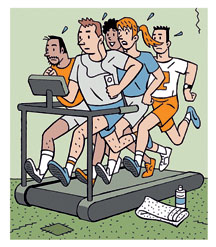
|
March 5, 2008: On the Campus
Illustration: Ron Barrett; Photos: Hyunseok Shim ’08 |
Treadmills and translations
 By
Jocelyn Hanamirian ’08
By
Jocelyn Hanamirian ’08
The last thing students want is to stress about their de-stressing time. But with long treadmill lines at peak hours and overused facilities, Dillon Gym has been a growing source of stress to students and faculty.
Rob Biederman ’08, former president of the Undergraduate Student Government, said that he received e-mails several times a week in the past year asking for more treadmills, greater availability of the basketball courts, and the opening of a side entrance to the Stephens Fitness Center that is currently closed.
Biederman said that while Firestone Library is slated to receive a 10-year renovation that will begin in two years, the renovations at Dillon are far more important to the USG. “Relative to other colleges, we probably have one of the best libraries and by far one of the worst fitness centers,” he said.
Katie Lawrence ’08 is a spinning instructor who uses Dillon six to seven times a week for teaching four classes and taking part in intramural sports and fitness classes. “I definitely think Dillon is in need of more funding and renovation,” she said. “The line waiting for treadmills at peak predinner time can be up to 20 minutes.”
Lawrence would like to see more treadmills, more working machines, and sound input on the machines so that students can listen to the televisions in the gym on headphones.
In February, economics professor Gene Grossman wrote an op-ed to The Daily Princetonian citing the need for a gym that makes exercising convenient, especially for professors who often do not have the opportunity to return home to shower after a midday workout.
“Dillon felt outdated when I arrived at Princeton — in 1980 — and has barely changed since,” Grossman wrote. “The mustard yellow walls with exposed piping are depressing. There are far too many lockers, half of which sport broken doors. The exercise equipment is insufficient for demand and too often in disrepair.”
Executive vice president Mark Burstein said the University’s capital campaign includes $10 million for renovations to Dillon.
But for now, the only ready answer for students and faculty seeking Dillon improvements may be to just keep pedaling.
 By
Bianca Bosker ’08
By
Bianca Bosker ’08
Ernest Brewster, a senior in the history department whose thesis requires translating 5th- and 6th-century anti-Buddhist polemics from classical Chinese into English, believes translation is neither science nor art, but a craft. Given that in classical Chinese a single character can be interpreted as a noun, adjective, or verb, translating meanings between the languages has been no easy task.
This year the University has launched a new certificate program aimed at studying precisely the problems with which Brewster has grappled in his thesis. The Program in Translation and Intercultural Communication does not provide translation training, but instead aims to sensitize students to the technical, theoretical, and ethical issues involved in moving ideas between languages.
To receive the certificate, students must complete two core courses in translation analysis, take at least one class on translation practices (which could address anything from the philosophy of language to the dilemmas of translation by computer programs), and three electives. Students also must show proficiency in at least one foreign language, study abroad, and incorporate translation into their independent work.
Faculty and undergraduates alike have responded enthusiastically to the program, and Brewster said he is disappointed that he will graduate too soon to earn the certificate. “[The program] seems to provide a rigorous environment in which to immerse myself in theory and issues relating to practice of translation, which has posed unique challenges that have been vexing for my thesis work,” he said.
Program director David Bellos estimates that in the first year 10 to 12 students from the Class of 2010 will pursue the certificate, but he expects the number to increase quickly.
“So much is happening now in our world to suggest it is important
that we understand other languages and cultures,” explained Sandra
Bermann, chairwoman of the comparative literature department, who developed
the program in collaboration with her colleague Michael Wood. “Globalization
means the interwovenness of financial, military, religious, information,
and other networks. With that come issues of translation and cultural
communication that we must respond to openly, reflectively, and wisely.”
![]()
MOREONTHECAMPUS ONLINE: Artwork in the deli; “Princeternships” begin, click here.

To read our exclusively online On the Campus column, click here.
